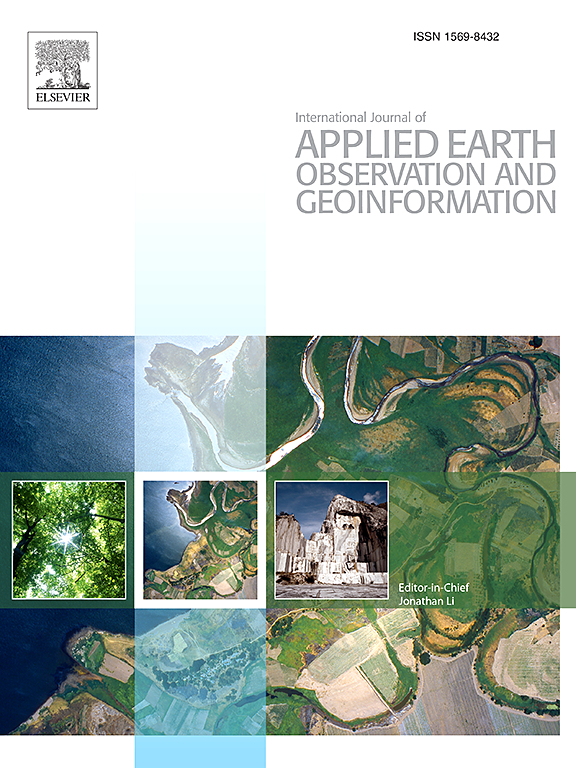利用时空自相关分析气候变化对中国植被绿度变化趋势的影响
IF 7.6
Q1 REMOTE SENSING
International journal of applied earth observation and geoinformation : ITC journal
Pub Date : 2025-04-21
DOI:10.1016/j.jag.2025.104548
引用次数: 0
摘要
植被绿度的趋势分析和归因分析对于解释和预测生态系统对气候变化的响应至关重要。从遥感时间序列中检测和解释绿度模式的常用方法大多是基于逐像素分析,往往不能考虑空间自相关,可能导致伪模式。本文采用分段自回归时间序列(Partitioned Autoregressive Time Series, PARTS)方法对第3代归一化植被指数(NDVI3g)数据和多个气候数据集进行分析,分析了气候对中国绿化趋势的影响。该方法考虑了时空自相关结构,对像素信息进行聚合,严格检验了区域格局的假设。结果表明,绿色度趋势受气候变化、环境背景及其相互作用的强烈影响。在绿度较低、温度较高、降水和土壤湿度较多、水汽压亏缺(VPD)较低的地区,绿化率趋于较高。对于整个中国,温度(P <;0.05)和土壤水分(P <;0.05)对绿化趋势有显著的负向影响,而降水趋势(P <;0.05)和VPD (P <;0.001)产生显著的正影响。但它们的影响与环境背景有很强的相互作用。随着VPD水平的增加,VPD的总体积极影响显著增强(P <;西北干旱区VPD显著正影响(高VPD),热带和亚热带地区VPD显著负影响(低VPD)也支持了这一结论。在寒冷生态系统中,土壤湿度的变化对绿化趋势有显著的负向影响。该研究为绿色变化的驱动机制提供了新的见解,有助于为生态系统建模提供准确的预测。此外,该分析框架可以有效地应用于其他区域或其他生态系统对气候变化的响应分析。本文章由计算机程序翻译,如有差异,请以英文原文为准。
Accounting for temporal and spatial autocorrelation to examine the effects of climate change on vegetation greenness trend in China
Trend and attribution analysis of vegetation greenness is crucial to explain and predict ecosystem responses to climate change. The common practice to detect and explain greenness pattern from remote sensing time series is mostly based on pixel-by-pixel analysis, which often fails to account for spatial autocorrelation and may lead to spurious patterns. Here we applied the Partitioned Autoregressive Time Series (PARTS) method to the Normalized Difference Vegetation Index-3rd generation (NDVI3g) data and multiple climate datasets, and examined the climate effects on greenness trend in China. This method considers temporal and spatial autocorrelation structure, and aggregates pixel information to rigorously test the hypotheses about regional patterns. The results showed that greenness trends were strongly impacted by climate change, environmental background and their interactions. In regions with lower greenness, higher temperature, more precipitation and soil moisture, and lower vapor pressure deficit (VPD), the greening rate tends to be higher. For the whole China, long-term trends of temperature (P < 0.05) and soil moisture (P < 0.05) made significantly negative effects on greenness trend, while trend of precipitation (P < 0.05) and VPD (P < 0.001) made significantly positive impacts. But their effects strongly interacted with environmental background. The overall positive VPD impact was significantly enhanced with an increase in VPD level (P < 0.001), which was also supported by the significantly positive VPD impact in the northwestern arid regions (high VPD) and the significantly negative impact in the tropical and subtropical areas (low VPD). In the cold ecosystems, the change in soil moisture made significantly negative effect on greenness trend. This study provides new insights into the driving mechanisms of greenness change, which is useful to inform ecosystem modeling to make accurate predictions. Moreover, the analysis framework with PARTS method could be effectively applied to other regions or to analyzing other ecosystem responses to climate change.
求助全文
通过发布文献求助,成功后即可免费获取论文全文。
去求助
来源期刊

International journal of applied earth observation and geoinformation : ITC journal
Global and Planetary Change, Management, Monitoring, Policy and Law, Earth-Surface Processes, Computers in Earth Sciences
CiteScore
12.00
自引率
0.00%
发文量
0
审稿时长
77 days
期刊介绍:
The International Journal of Applied Earth Observation and Geoinformation publishes original papers that utilize earth observation data for natural resource and environmental inventory and management. These data primarily originate from remote sensing platforms, including satellites and aircraft, supplemented by surface and subsurface measurements. Addressing natural resources such as forests, agricultural land, soils, and water, as well as environmental concerns like biodiversity, land degradation, and hazards, the journal explores conceptual and data-driven approaches. It covers geoinformation themes like capturing, databasing, visualization, interpretation, data quality, and spatial uncertainty.
 求助内容:
求助内容: 应助结果提醒方式:
应助结果提醒方式:


